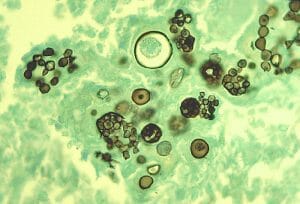Dimorphic fungi can live in four different forms; mold, hyphal, filamentous or as a yeast. Many species of dimorphic fungi are pathogenic to humans and other organisms. In humans, temperature is the main regulator of the form the fungus takes. Students of medical mycology are taught the memory aid “Mold in the cold, yeast in the heat” to help them remember this.
An example of a dimorphic fungus is Penicillium marneffei. It is a mold at room temperature but becomes a yeast when it infects humans. It is the only species of Penicillium that shows dimorphism due to changes in temperature.

The image above shows the spherule (spherical shaped) and filamentous forms of the dimorphic fungus
References
- Dimorphic Fungus. (n.d.). In Wikipedia. Retrieved January 9, 2018 from https://en.wikipedia.org/wiki/Dimorphic_fungus
